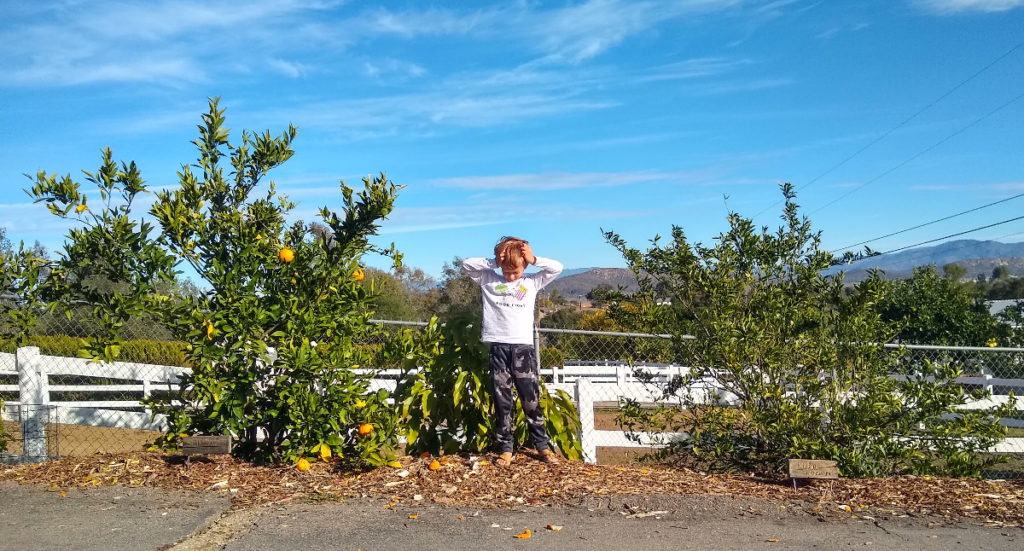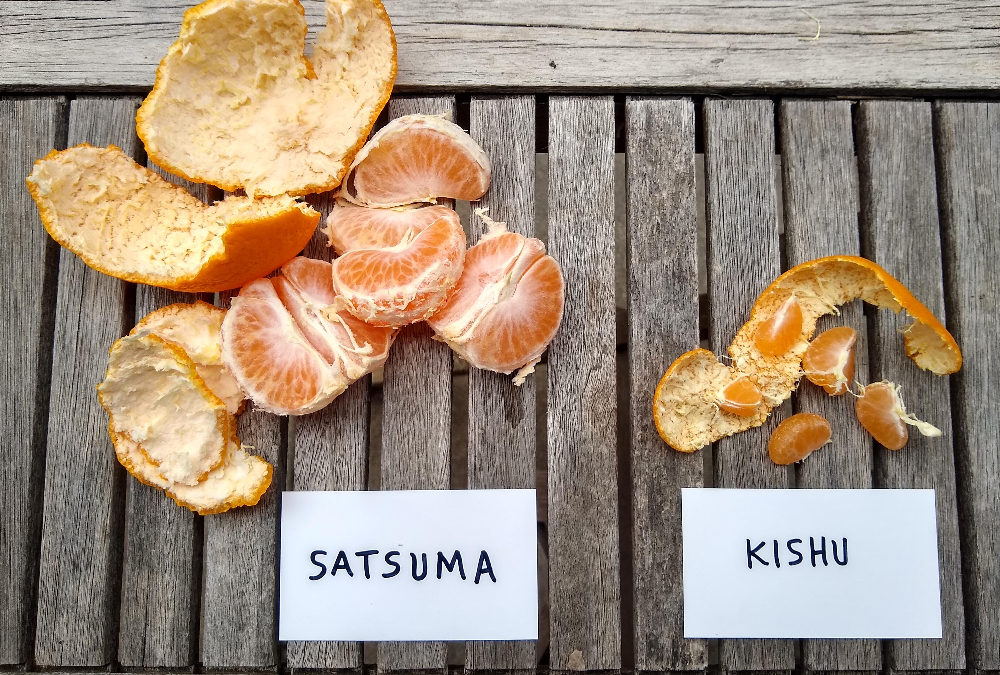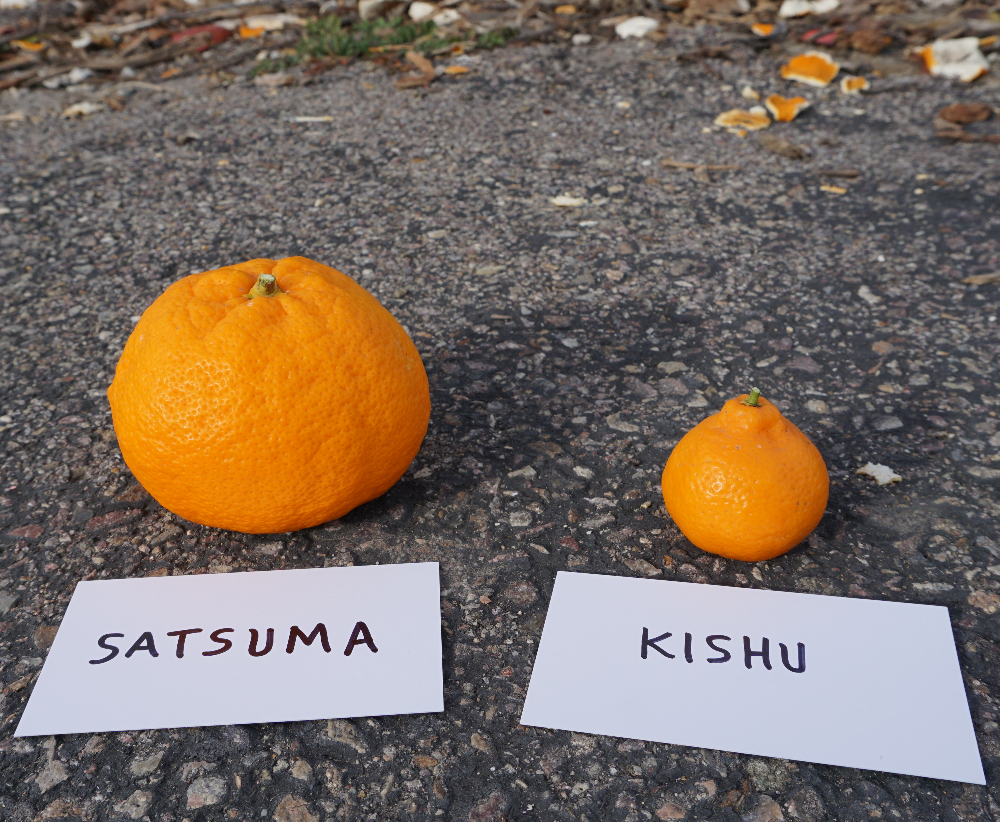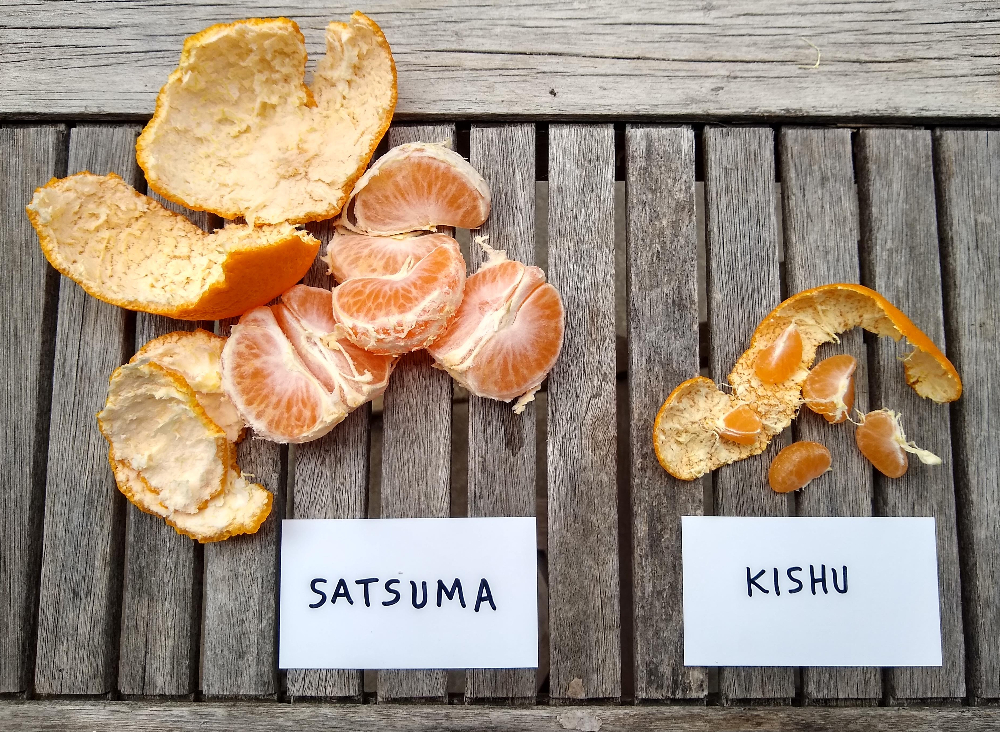Choosing a mandarin tree to plant can be overwhelming because of the abundance of varieties available to us in California. One way to narrow the possibilities is to consider seasonality. Among the types of mandarins that ripen earliest, I grow two that I like and that are widely available for purchase at nurseries: Satsuma and Kishu.
Would one of these be suitable for your yard and family? How do they compare?
Fruit eating qualities
The size of the Satsuma mandarin is far larger than Kishu. A Satsuma is only a little smaller than an orange. A Kishu is very small, not much bigger than a golf ball.
Both are considered seedless, but I often find a single seed in a Satsuma whereas I can’t remember ever finding a seed in a Kishu.
Both peel very easily, especially later in their seasons when their peels get “baggy.” A Satsuma’s peel is much thicker and bumpier than Kishu’s though.
Once peeled, the Satsuma segments inside still have many strings and pith attached. It can take a little extra work to get those off if you don’t like to eat them. However, Kishu segments are relatively clean once the peel is removed.
Here’s that photo again:
Eating a Kishu is a refined experience: the membrane around the segments is thin and the juice vesicles inside are imperceptible. The flavor is richly sweet although not remarkable. There’s no tang, no extra anything to put your finger on. You can be patient and eat the fruit segment by segment or you can easily eat a whole Kishu in one or two bites.
Eating a Satsuma is a meatier experience: there’s plenty of membrane to chew on and fat juice vesicles to explode. The flavor is slightly more distinct than Kishu, and it is the same flavor as canned mandarins. It’s nearly a full snack to eat a whole Satsuma.
Tree characteristics
The Kishu tree is smaller and bushier compared to the Satsuma. My Kishu is about six years old (planted from a five-gallon container) and is barely as tall as me. My Satsuma is a year younger and I’ve pruned it a bit, but it is already taller than me.

Both trees have produced well each year, but the Kishu has been a little more productive in terms of number of fruit.
While the two varieties are early season mandarins, the Kishu fruit becomes palatable a bit ahead of the Satsuma fruit. My kids start eating the Kishus after Halloween although I don’t find them appealing until closer to Christmas.
At that time, I’m lucky if I get any because the Kishu fruit is their favorite out of all of our citrus. It’s easy for the kids to peel, and it’s easy for them to chew, and the fruit is small enough for even a two-year old to finish.
The Satsumas end up being my snack tree because the kids find it harder to peel, seedy (one seed in a fruit is “seedy,” they say!), and too big. This is all compared to the Kishus.
(See my post about Kishu and the kids.)
Sometime in January, the Satsuma fruit starts to dry out inside. Satsumas don’t hang on the tree with quality for very long after they’ve become sweet. But they provide a couple months of delicious winter snacks.
Around February or March, our family switches from eating Satsuma and Kishu mandarins to navel oranges and later mandarin varieties.
(See my post, “Oranges and mandarins fresh off the tree almost all year.”)
Bottom line
If I could only have one of these early mandarin trees, which would I choose? I would keep the Kishu. Partly, that’s because the kids adore it, but I also don’t mind its small size. I just grab more than one if necessary.
Is Kishu or Satsuma right for you? Some people find Kishu’s diminutive size annoying. If you suspect you’d prefer a larger, meatier mandarin — with a somewhat richer flavor — then go Satsuma.
In this video I peel, taste, and talk Satsuma and Kishu mandarins:
Read a bit more about Satsuma (Frost Owari) and Kishu (Seedless) on the Citrus Variety Collection website of U.C. Riverside.
All of my Yard Posts are listed HERE






Hi Greg! I read in another post that you planted the Satsuma because you couldn’t find a USDA 88-2/Lee x Nova tree. I am wondering if you have any info on how the two compare in taste and texture. Thanks!
Hi Sara,
I now have a USDA 88-2 tree (now officially named US Superna although I don’t know anyone who likes that name or calls it that), but it was run over by a tractor last year and I’ve yet to get fruit from it.
See David Feinglass’s report on his tree’s fruit in the comments in this post: https://gregalder.com/yardposts/oranges-and-mandarins-fresh-off-the-tree-almost-all-year/
And see more info on 88-2’s taste and texture here: https://citrusvariety.ucr.edu/citrus/88-2.html
And here: https://citrusvariety.ucr.edu/citrus/documents/USSupernaUSDA88-2ReleaseNotice.pdf
I haven’t eaten 88-2 mandarins for a decade now, but when I last ate them I took these notes: “super tasty, mild and unique flavor, peels well.” And I considered it a tree I must have. Well, I technically do have a tree.
Thank you for this info, Greg. And yikes! Sorry to hear about your tree. Amazing that it can survive being run over by a tractor though. I hope it recovers and bears some fruit for you soon.
Thanks again!
Sara
My Satsuma has a wonderful taste too but it is an alternate bearer. So, I got another to see if I could get lucky and have one of them producing while the other is taking the year off. Did the same with my Kishu (got two)although the Kishu is not as prone to alternate bearing as my Satsumas. The Kishu, BTW, is like peeling a sugar cube. Amazing how something natural can be so sweet and delicious!
Hi Greg: I have an older Satuma; al
ways bear fruit but the fruit is small. Also, a lot of dead wood inside. I wonder, can you open the canopy by pruning to get more sun lite and larger fruit? Also, do you fertilize?
Tom
Hi Tom,
A few things contribute to larger fruit. One is fewer fruit. If a tree has few fruit, that fruit will be larger than during a year with a heavy crop, all other things being equal. I’ve seen this happen especially on my Valencia orange tree.
Another is adequate water. If the tree doesn’t have enough water available through its roots, it pulls water from its fruit, thereby decreasing the fruit size. I’ve seen this happen when I’ve stopped irrigating my Bearss lime tree and my Dancy tangerine tree.
I don’t know that increased sunlight makes for larger fruit. I’ve never seen evidence of that. In fact, I have seen the opposite happen on my Valencia, which has its largest fruit on the interior of the canopy.
I personally don’t fertilize my citrus much. I keep a thick layer of wood-chip mulch under them, and that’s about it.
But researchers have found that certain fertilizers sprayed on the leaves of mandarins can increase their fruit size. Here’s a paper on that done by Carol Lovatt of U.C. Riverside: https://lovattresearch.ucr.edu/sites/g/files/rcwecm3361/files/2019-12/tech_lovatt_2013.pdf
Lovatt has also done trials on spraying a hormone called gibberellic acid on mandarin trees to increase fruit set and fruit size: https://www2.ipm.ucanr.edu/agriculture/citrus/Fruit-Set-with-Gibberellic-Acids-GA3/
There are 3 major types of Satsuma trees. The type you usually find in the store is the Owari Satsuama. Evergreen nursery was bought out and their tree prices are 4X as high, so I don’t go there any longer, but I have several Miho Wase Satsuma trees from there several years ago. My Okitsu Wase Satsuma dwarf tree lasted a few years and then died. All produce great similar fruit, but to me the Miho Wase Satsuma is the best – the taste is a little different. I didn’t get enough fruit from the Okitsu for a fair evaluation, but it had won a taste test done by the “fruitmentor”. If I could only buy one Satsuma tree it would be the Miho Wase. Time flies – I guess my Satsuma trees are 5 or 6 years old.
Thanks for adding this, Rick.
Hey Greg, I got a kishu last year after reading your post. I’m just down the hill from you and it produced great for its first year. We got about 2 dozen and the fruit is great. Thanks for the info!
Greg, I enjoy ur newsletter. Learning a lot. I planned a Mexicaloa Granda avocado about 15 years ago. It was growing too tall so last year pruned it way down. Before 25 feet now 15 feet. Now all of it limbs have flowering buds. Looks very good.
Main reason emailing you, I think I screw up.
I am planning to plant lemon tree in a raised bed 3 feet sq. I dug hole 2 feet deep an mixed chicken Manure an original soil. I accidentally added potty soil. Will it b ok? Should I add extra bag of soil admendment. Appreciate ur advice. Btw live Fresno
Hi Anthony,
Thank you. I’d guess everything will be alright. The potting soil is probably mild in terms of fertilizer, and potting soils usually drain fast (not a problem as long as you water frequently enough, especially in summer). Hope you get great fruitset on your Mexicola Grande for this year!
Hi Greg, there’s nothing better than a good Satsuma in my opinion. They can be a bit seedy but it is by far my favorite citrus.
I actually have a small Satsuma and Reed Avocado tree but both are looking quite sickly. Last year my Satsuma fruit set was weak and many of them only grew to be the size of a gumball. The leaves have spots too and there’s very limited new growth. Same with my Reed, spots on the leaves and they’re pretty yellow. Is there a way that I can send you a couple of pictures to get some help on what to do about them?
I find your information very interesting, well written and informative. Thank you!
I’m interested in purchasing a Kishu Mandarin tree in Southern California? Would you be able to inform me on where I can do this?
Thank you, Sochi! Kishu trees are widely available at good nurseries. If you don’t have an independent nursery near you, look for an Armstrong.
Found these articles by mistake. I like how they’re thoroughly written. Thank you for sharing your experience. Mike